Situational Report #3: An Analysis of the Sentiments Around the Protests in Kenya

Jul 22, 2024
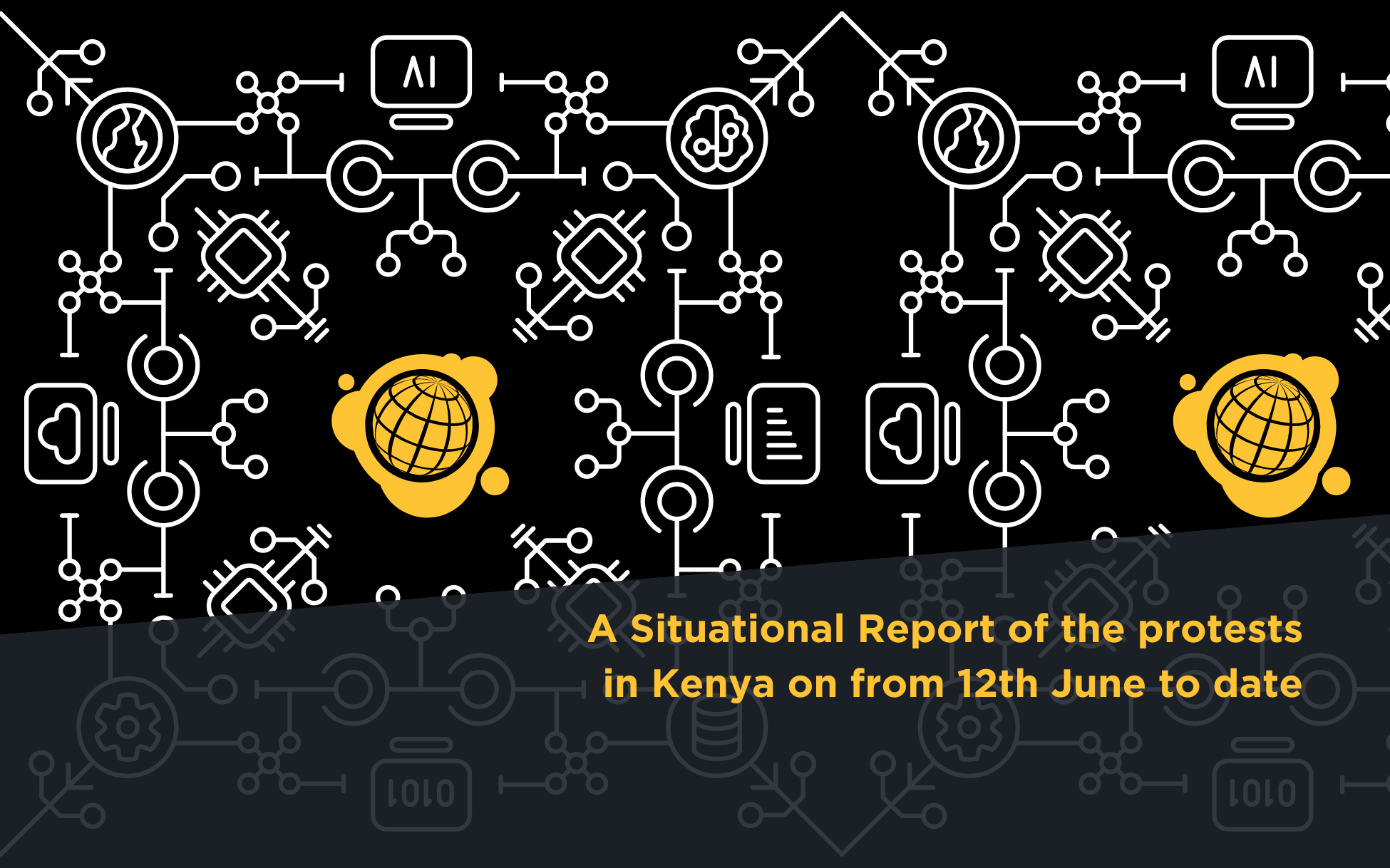
For over a month now, Kenya has been rocked by protests across the country. These protests began as a show of Kenyans’ disapproval of the 2024 Finance Bill that was tabled in parliament. The Kenyan government hoped to leverage it to increase revenue by introducing and increasing various taxes and levies. Key elements of the bill included increased VAT on essential goods, introduction of new taxes on digital transactions, and higher excise duties on fuel. The bill sparked widespread public outcry, with critics arguing that it would disproportionately affect low-income households and small businesses. The protests have been termed as the “greatest in the history of Kenya” and have mainly been organized by the youth and Gen Z in particular. Even though the President bowed to pressure and withdrew the bill, the youth have vowed to continue with the protests until the state of the economy and governance changes.
From Finance Bill Protests to Broader Governance Concerns: A Shift in Focus
As a result, the discussion around the protests shifted from the Finance Bill to governance, the rule of law, and the state of the country. Kenyans are now demanding a total overhaul of the country’s politics and the addressing of pertinent policy issues. The youth have expressed their anger and their disappointment with the government over the killings of their fellow youth during the past protests.
The pressure seems to be increasing with the president being seen to take austerity measures within his government. In a press briefing on 5th July, the President said, following wide consultations, his government has settled on implementing austerity measures such as:
- Cutting down on various costs, including dissolving at least 47 state corporations with overlapping functions.
- The suspension of hiring of Chief Administrative Secretaries (CAS).
- Reduction of advisers in government by at least 50 per cent and with immediate effect.
- Removal of budgets in the Offices of the First Lady, the Second and the Spouse of the Prime Cabinet Secretary.
- Removal of the confidential budgets in executive offices.
- Budget for renovations across the government was reduced by 50%.
- Civil servants who attain the age of 60 will be required to retire immediately and no extensions will be allowed.
- Suspension of the purchase of new motor vehicles in government for one year, except for security agencies.
- All non-essential travel by state officers was also suspended.
- Participation of public servants in Harambees (fundraisers) was also banned.
Despite the austerity measures, many Kenyans remained skeptical of the president's intentions, viewing these measures as mere PR stunts aimed at pacifying young protestors. This was further exacerbated after the president reappointed members from the previous cabinet in his recent press statement and announced others who have previously been charged in various court cases, including graft.
In a live interview with journalists on the 30th of June, President Ruto made claims about his performance, the state of the country’s books, food prices, and budget allocations among other things. Africa Check, used its artificial intelligence tools to extract verifiable claims from the interview for a closer look. Out of the 18 claims that they had a close look at, 6 were correct, 6 were mostly correct, 1 was misleading, and 5 were incorrect. Here is a detailed report.
Digital Activism: Kenyans Take Protests Online
Kenyans online have now moved a step further in their quest to hold politicians to account. Despite the President ceding to their demands to withdraw the finance bill, Kenyans have pointed out that it was merely the first step in taking back the power to the people. Not just armed with chants, water bottles and placards anymore, the young Kenyans are now resorting to technology as the anti-finance protests morph into anti-government. They have been leveraging X spaces, TikTok and other digital platforms to discuss issues facing the country. The X spaces have seen tens of thousands of Kenyans joining to air their grievances. In a move seen as the first for a sitting president to engage directly on social media platforms, President Ruto engaged in a 2 hour X space with the Kenyans. The President’s X space attracted more than 150,000 thousand listeners and explored multiple issues, many of which were initially raised by protesting Kenyans. Pertinent issues including corruption in government and the incompetency of his cabinet were also raised.
One Kenyan identified as BenwithSon on X went a step further and generated an AI platform that provides information about the past corruption scandals that politicians and government officials have been involved in.

This is not the first time Kenyans have harnessed Artificial Intelligence to explain government policies and proposed regulations. A Kenyan by the name of Kelvin Onkundi introduced the Finance Bill GPT, which provided insights into complex clauses within the contentious bill.

In addition, online movements on X, such as #OccupyMOH, #OccupyJKIA and #OccupyChurches have been seen to gain traction, with conversations demanding transparency and accountability from the relevant institutions.
Innovative Communication Strategies for Translating the Finance Bill and other Governance Issues: Bridging Gaps in Public Understanding
Contrary to past demonstrations in Kenya that have featured rowdy crowds, destruction of property, and looting, the latest protests are quite different. Social media has become a powerful engagement, mobilization, and civic education tool, so much so that content creators have translated the Finance Bill 2024 and governance issues into vernacular languages. A report by Nendo, is evidence of high social media engagement and mobilization.
Impacts of Kenyan Protest Nationally and Globally
The protests have seen the president take what he terms as radical actions to reduce government spending (find some of the austerity measures by the president above). Other than that, the president sacked his entire cabinet ministers and the attorney general. In his statement he said that he will engage in extensive consultations with the aim of setting up a broad-based government that will assist him in accelerating and expediting the necessary, urgent and irreversible, implementation of radical programmes to deal with the burden of debt, raising domestic resources, expanding job opportunities, eliminating wastage and unnecessary duplication of multiplicity of government agency consequently making the government lean, inexpensive, effective and efficient.
Globally, the protests have garnered attention from international media, raising awareness about the issues facing Kenya. Similar movements and protests in other countries have drawn inspiration from the Kenyan protests, leading to solidarity protests and statements from global activists and organizations. The youth - led protests have inspired similar actions in other parts of the continent, including Nigeria, Malawi, Uganda and Nigeria, with the youth in these countries announcing dates for protests against the government.
Use of Technology: The Kenyan protests have showcased the role of technology and social media in organizing and amplifying protests, serving as a case study for digital activism globally.
Innovative Approaches: The innovative communication strategies used in the protests, such as real-time updates and online mobilization, provide lessons for activists and organizers worldwide.
Utilization of the Ushahidi Platform
The Ushahidi team set up an instance of our open-source platform, the Reject Finance Bill 2024 Tracker to help with social listening on social media mainly X (formerly Twitter) where citizens shared their displeasure about the finance bill, while also keeping track of missing persons allegedly abducted by security forces, incidences of police brutality, and help being provided by various human rights, legal and medical agencies.
The deployment has so far pulled in more than 1,200,000 organic tweets (and counting). In partnership with Dataminr AI for social good and additional technical support from Qhala, Ushahidi is currently in the process of classifying and categorizing these reports using Artificial Intelligence Models that have achieved 75% accuracy (so far).
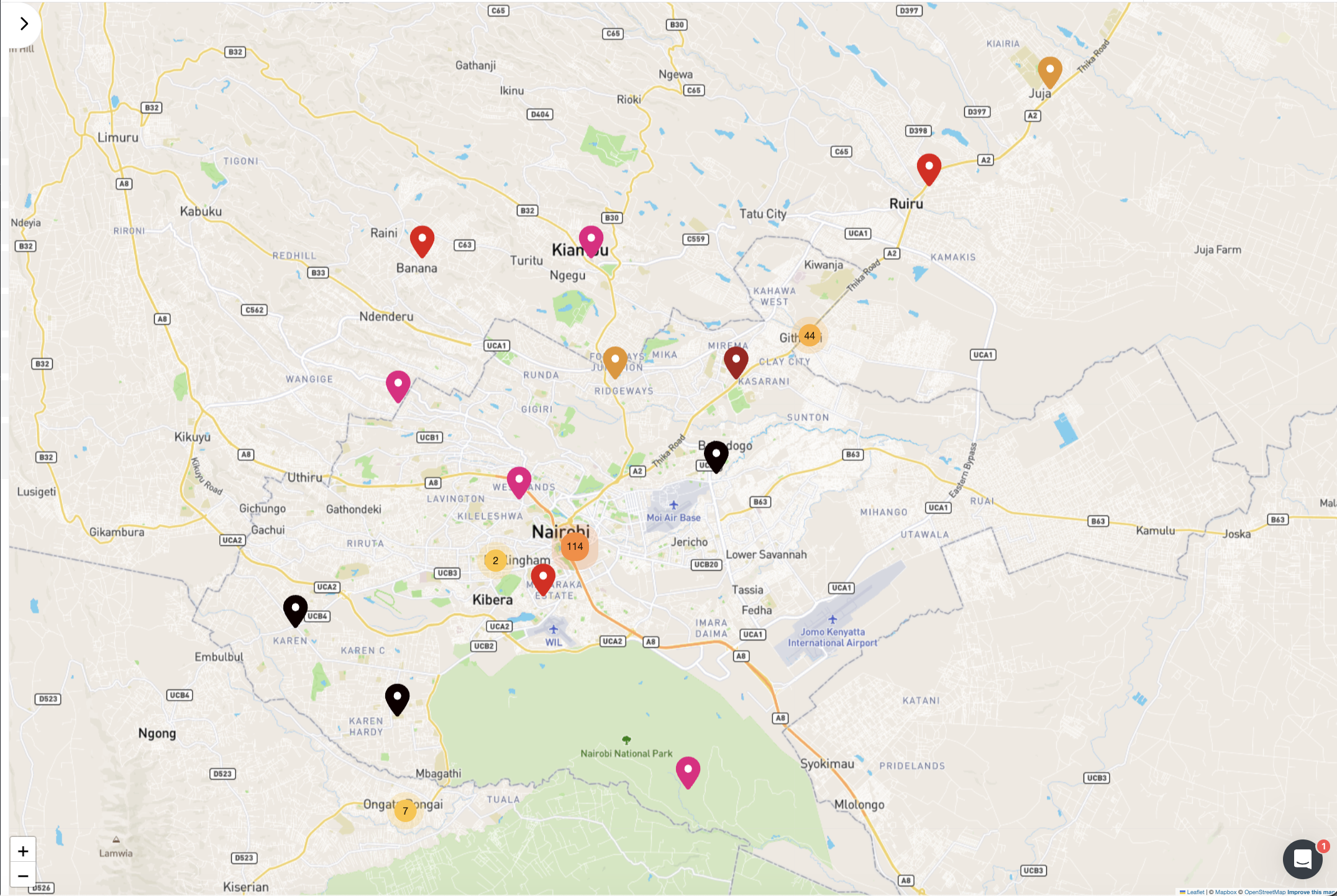
Breakdown of Peak Days (25th June, 27th June and 2nd July)
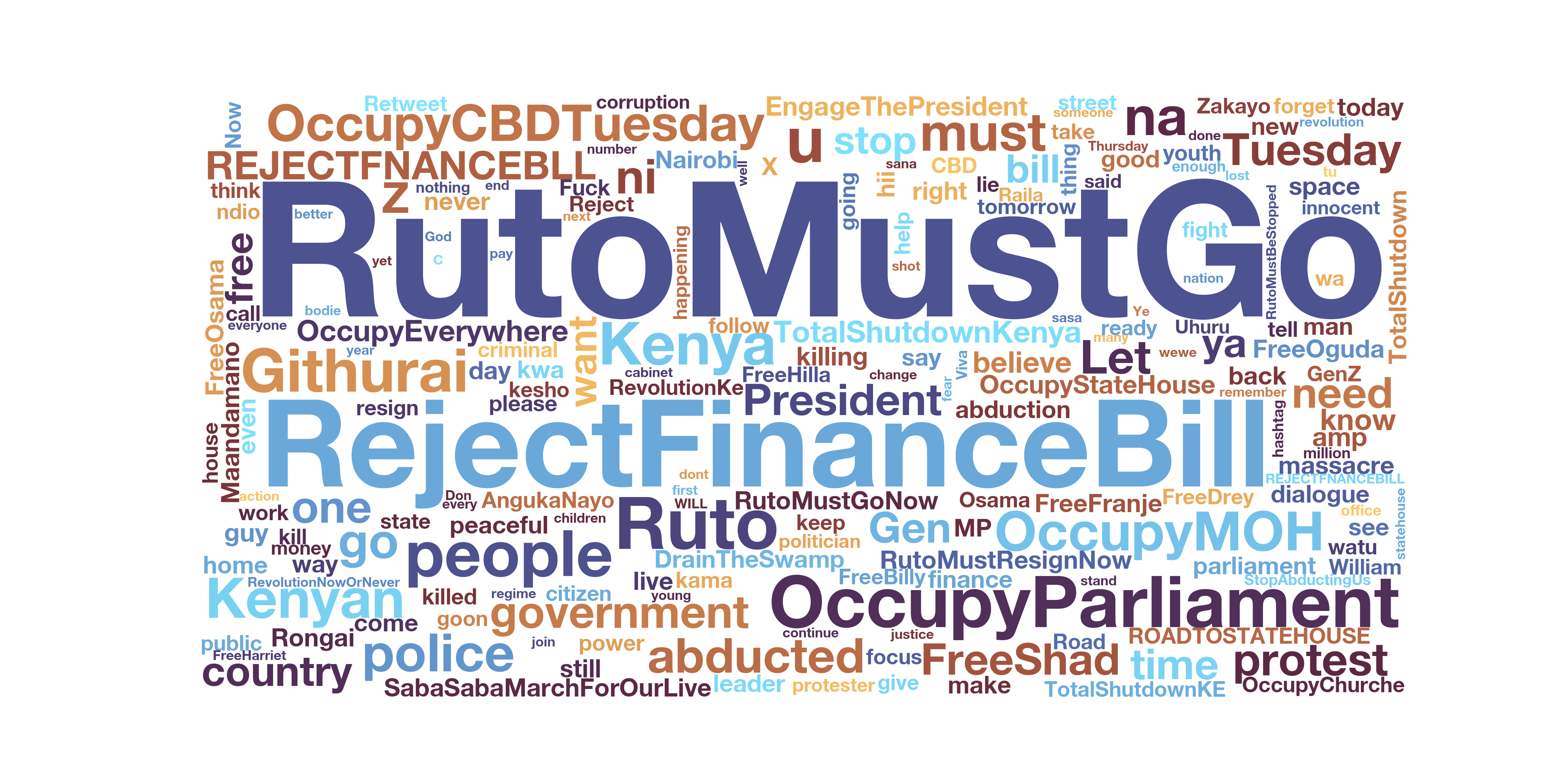
The word cloud highlights themes of political dissatisfaction, economic opposition, and strategic direct action. The predominant phrases collectively illustrate a determined movement with clear demands and organized tactics. The foremost demand for President Ruto's removal, Strong opposition to the Finance Bill, and Plans to occupy Parliament, central business districts, and the Ministry of Health to amplify their message and disrupt normalcy. The word cloud detects abductions with a call to free those abducted.
Breakdown of 25th June Reports
On 25th June, public sentiment was prevalent, with 70.6% expressing opinions on protests and the government. Additionally, other reports analyzed indicated: peaceful protests at 10%, missing persons at 9.4%, violent protests at 6.1%, police brutality at 2.5%, assistance provided at 1.0%, and internet shutdowns at 0.4%.
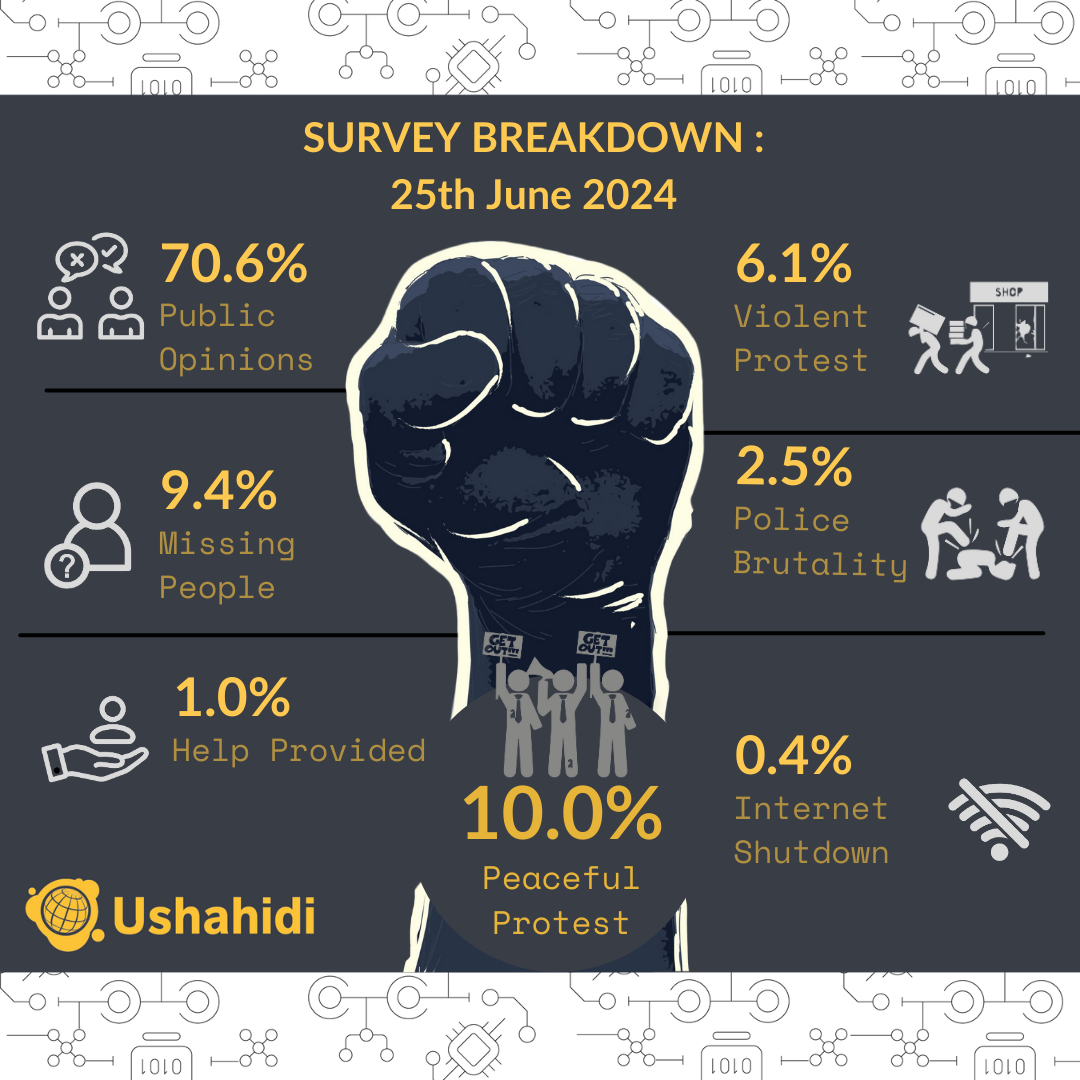
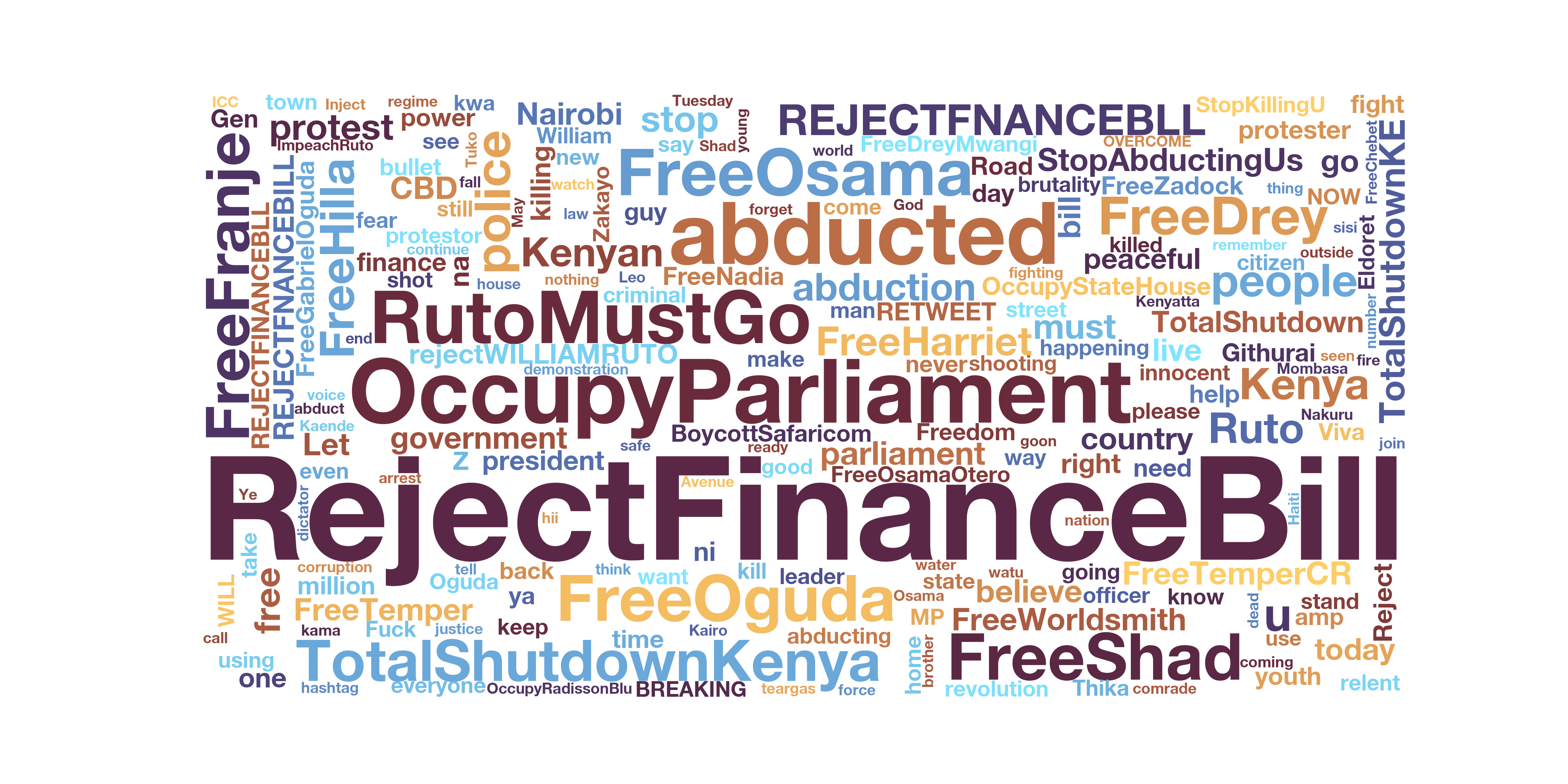
The word cloud highlights themes of economic justice, direct action, and political freedom. It illustrates the protestors' clear and urgent demands: rejecting the Finance Bill, demonstrating through occupation of political spaces, and advocating for the release of detained activists. These themes collectively paint a picture of a mobilized and determined populace pushing back against perceived economic and political injustices.
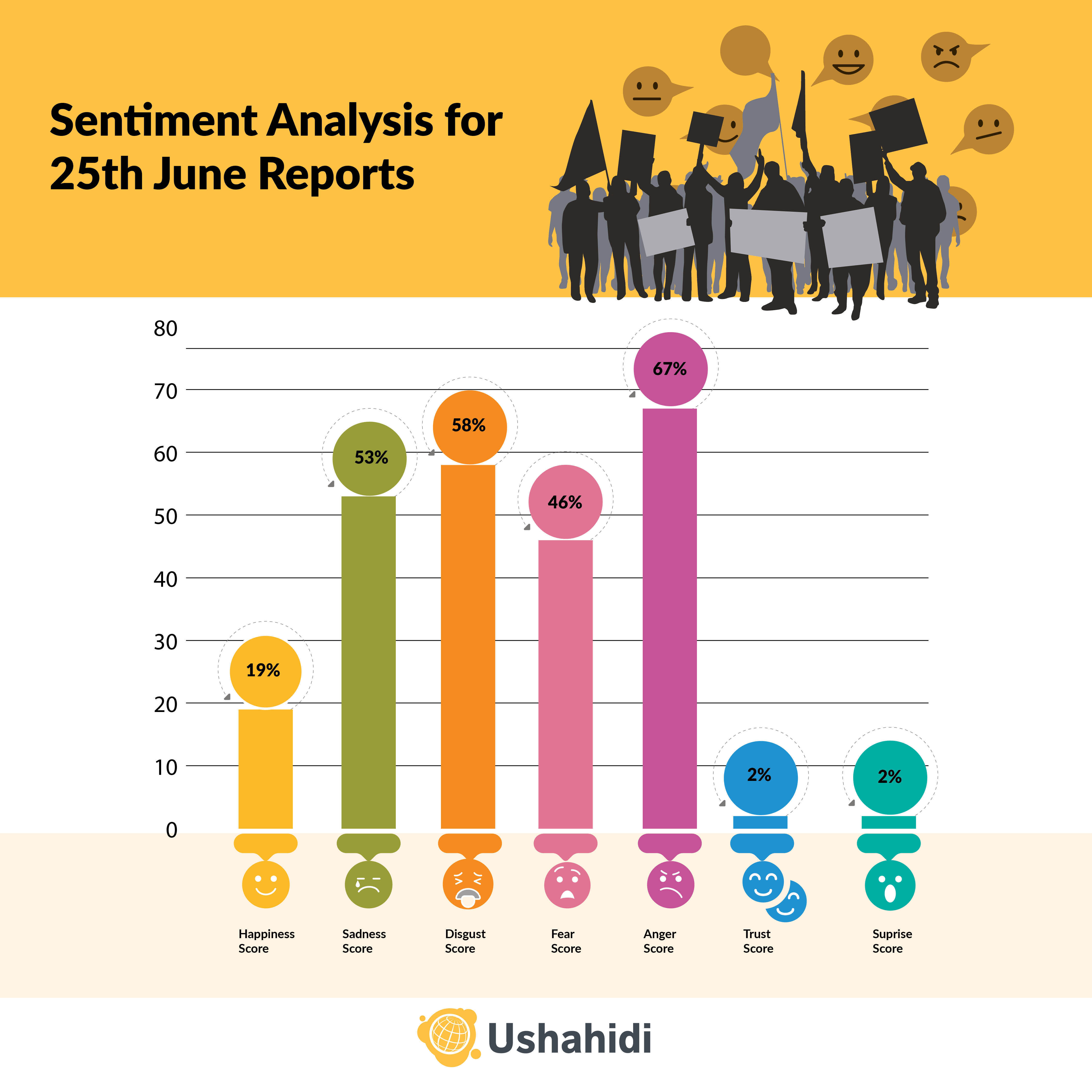
Breakdown of 27th June Reports
On June 27th, public opinion remained prominent, with 85.15% expressing views on protests and the government. Other submissions included reports of violent protests at 7.58%, peaceful protests at 2.76%, police brutality at 2.54%, missing persons at 1.58%, assistance provided at 0.34%, and internet shutdowns at 0.05%
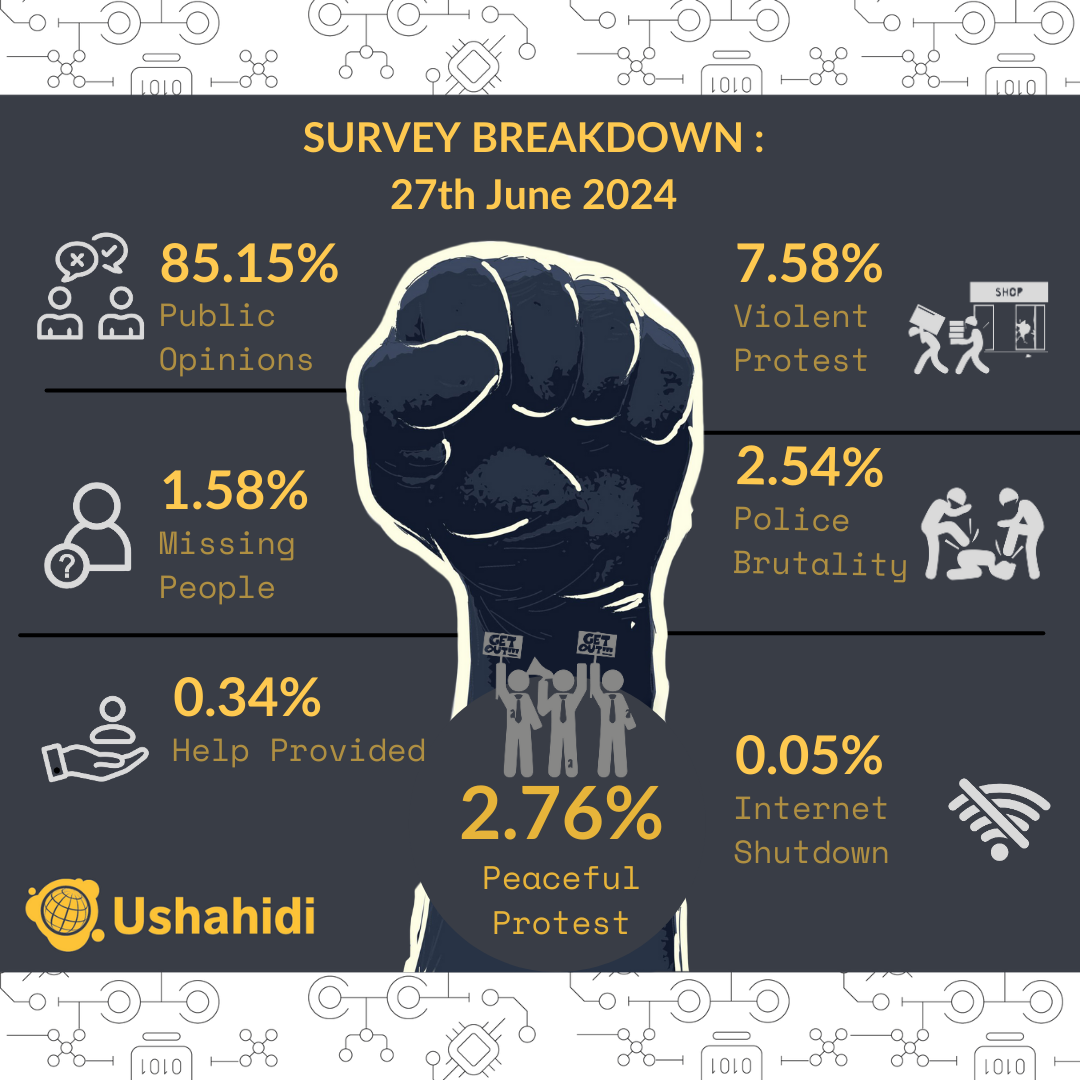
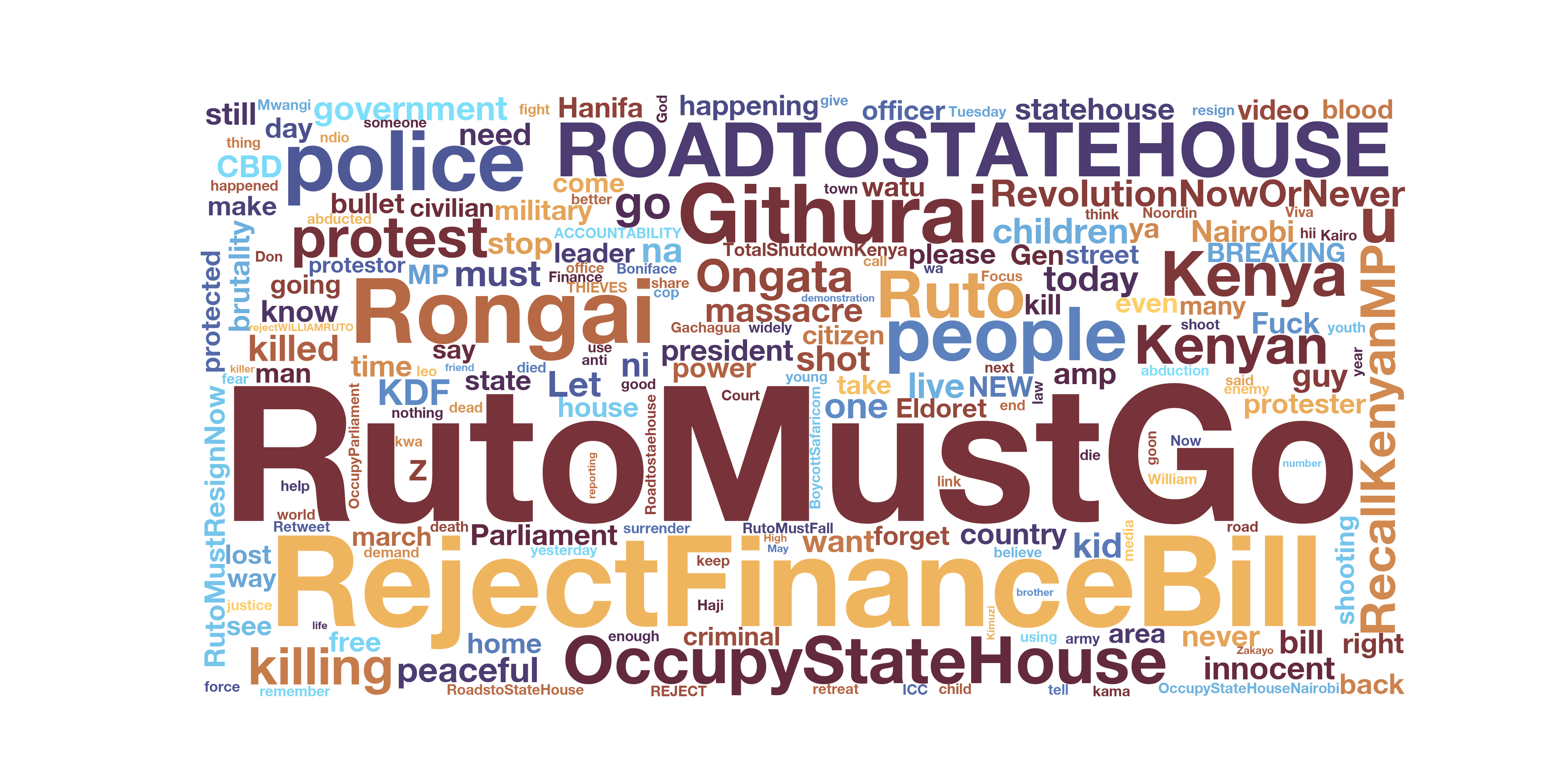
The predominant phrases collectively paint a picture of a populace deeply unhappy with current leadership and economic policies, mobilizing in key areas to demand significant political and economic changes. It is important to note that there is a shift from Reject Finance Bill phrases to Ruto Must Go indicating a citizenry tired of the government of the day and its leader and demanding a resignation. Githurai and Rongai appear to be predominantly due to the heavy protests experienced in the area with deaths reported.

Breakdown of 2nd July Reports
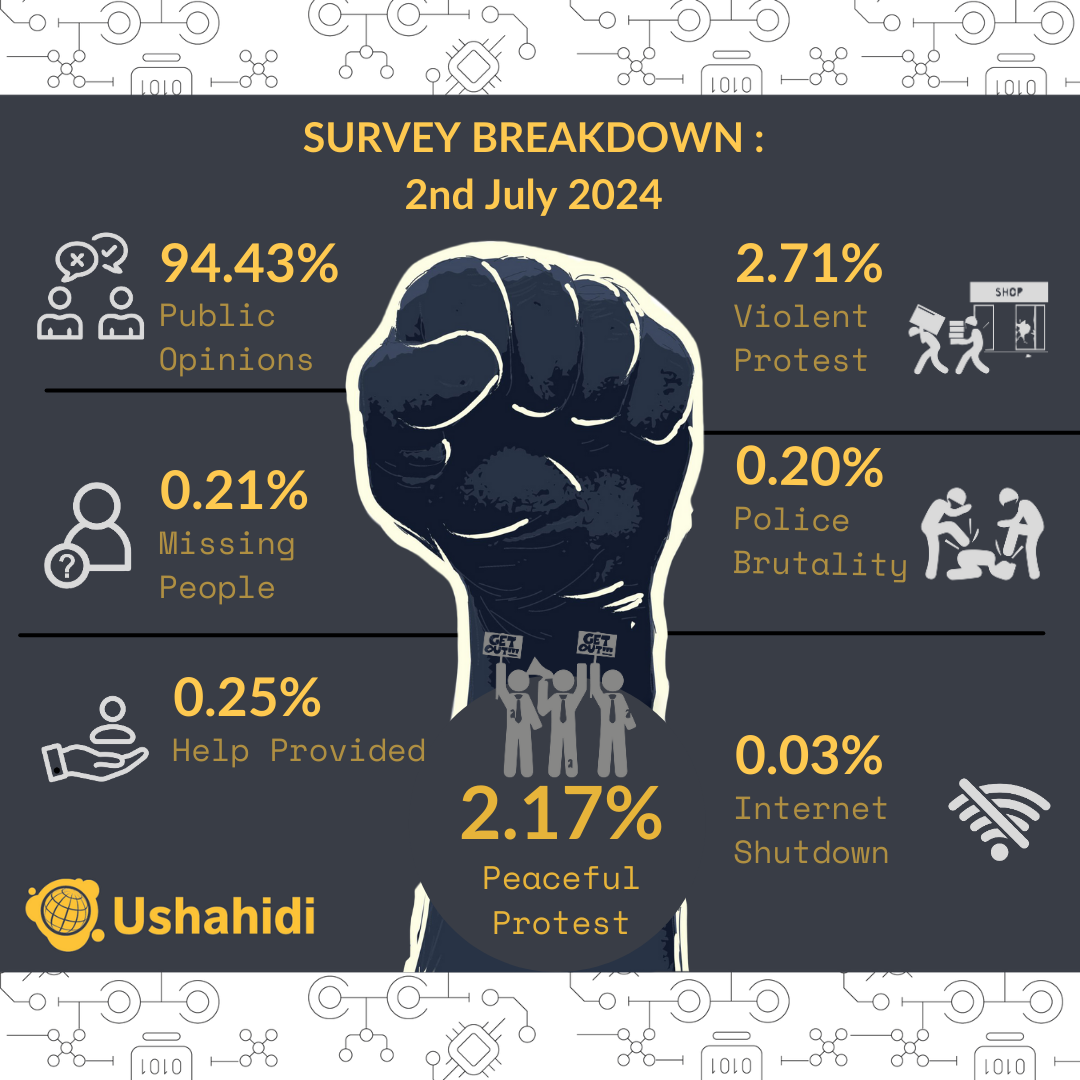
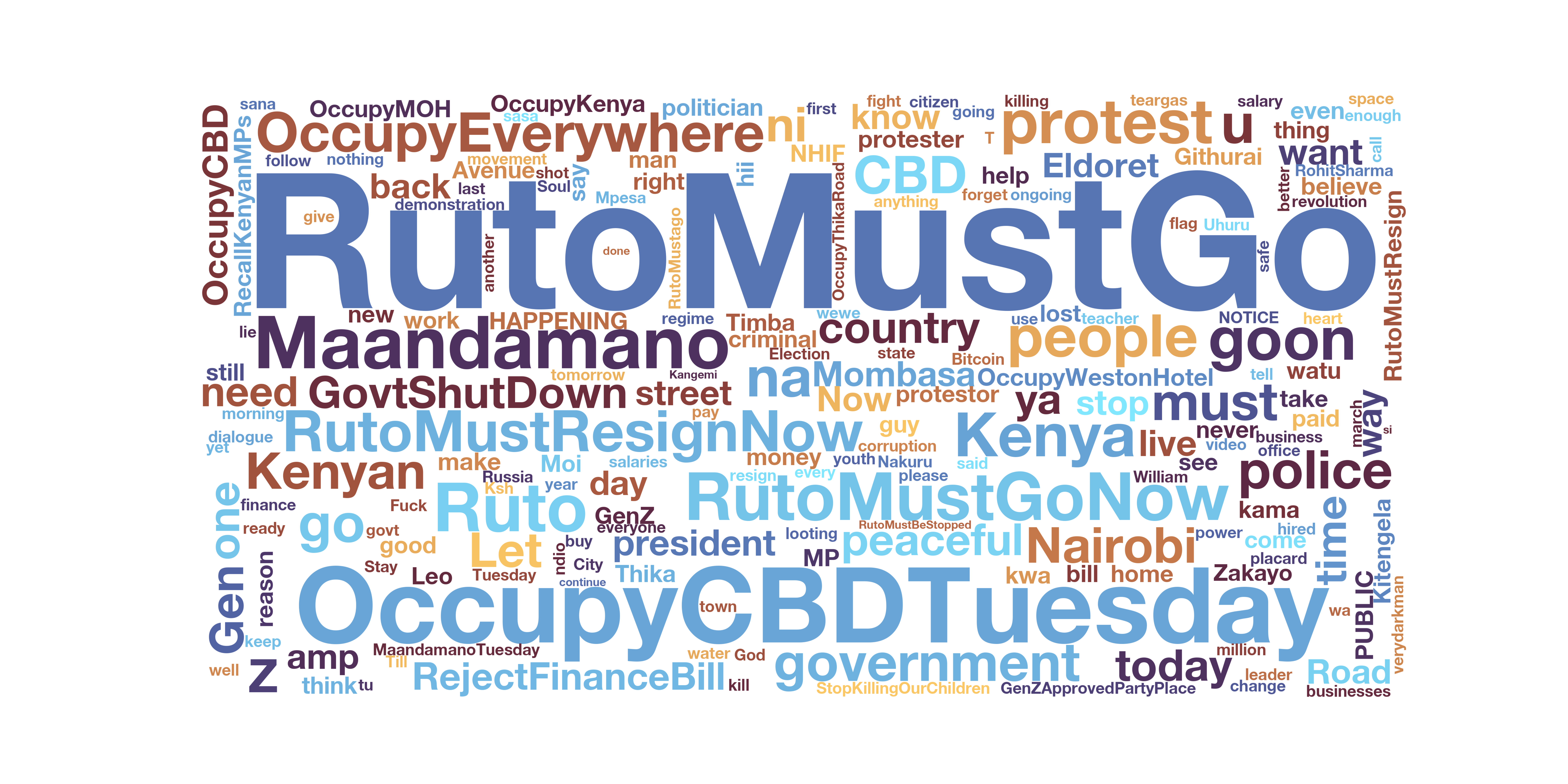
Ruto Must Go maintains its predominance with a call to Occupy the central business district on Tuesday. Important to note that even as the hashtags and opinions change, the call for the president to resign and go is still maintained.

Sentiment Analysis: Comparison of Detected Emotions
Protest Days
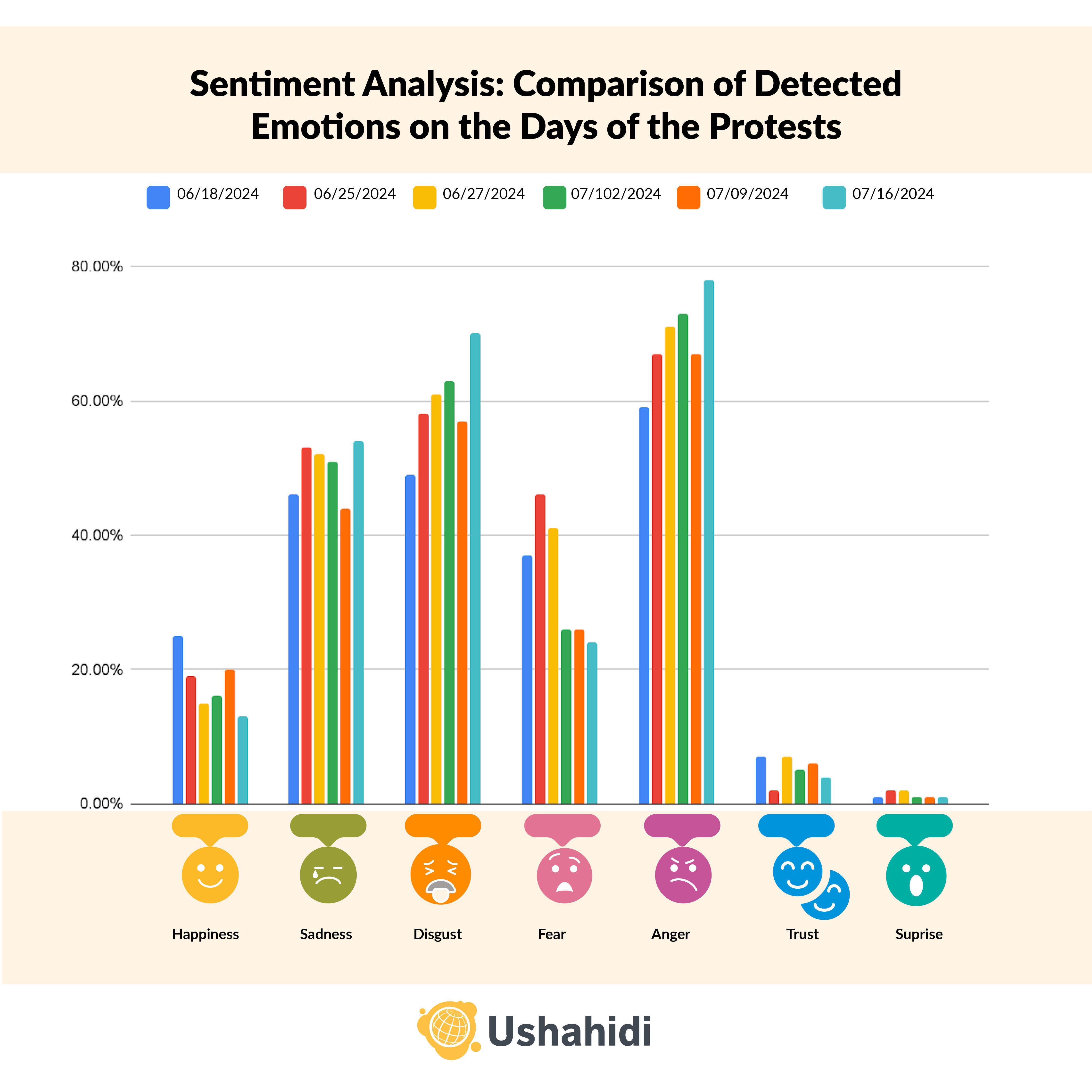
In examining the sentiments of Kenyans during the days of the protests, we see clear emotional trends that reflect the public's reaction to the ongoing events. One of the most striking patterns is the relationship between Disgust, Fear and Anger. Disgust has been increasing steadily indicating disapproval of the current regime by its people. Fear has been decreasing steadily even as the government deployed more police. This suggests that as the protests intensified and public outrage grew, the initial fear and apprehension among protestors lessened, perhaps as they became more determined or resolute. Anger and disgust often rose together, highlighting a strong correlation between these negative emotions. Both sentiments remained high throughout the period.
Ruto’s Public Appearances

In examining the sentiments of Kenyans during the president’s public appearances, we see clear emotional trends that reflect the public's reaction to the ongoing events. There is an inverse relationship between fear and anger during the president’s public appearances, with fear decreasing and anger increasing a possible indication of citizens’ anger on the president’s utterances and determination to resolve. Although trust remained low, the president’s public appearances have been taking it much lower, indicating widespread disapproval and a significant lack of confidence in the utterances. Interestingly, when the president dissolved the cabinet, anger and disgust remained all-time high, a possible indication of buildup anger and disgust.
Discovery of Dumped Bodies in Kware

When bodies were discovered dumped in a defunct quarry in South B, sadness, disgust, and anger remained high with people expressing their anger and dissatisfaction with the police.
Summary of the Sentiments
In examining the sentiments of Kenyans during the protests from June 12, 2024, to July 17, 2024, we see clear emotional trends that reflect the public's reaction to the ongoing events. One of the most striking patterns is the relationship between Happiness and Sadness. Happiness initially rose, peaking at 31% on June 14, but then steadily declined to a low of 11% by mid-July. On the other hand, Sadness increased over the same period, reaching 56% on July 12. This suggests that initial hope or optimism gave way to growing sorrow as the protests continued without resolution.
Disgust and Trust showed a stark inverse relationship throughout the protests. Disgust started high at 57% and peaked at 71% in mid-July, while Trust remained very low, fluctuating between 2% and 8%. This persistent high level of Disgust, paired with low Trust, indicates widespread disapproval and a significant lack of confidence in the government or the process.
Anger and Fear displayed an interesting converse relationship. Anger started at 64% and increased, peaking at 78% on June 28. Meanwhile, Fear initially rose but then decreased, dropping to 20% by mid-July. This suggests that as the protests intensified and public outrage grew, the initial fear and apprehension among protestors lessened, perhaps as they became more determined or resolute.
Anger and Disgust often rose together, highlighting a strong correlation between these negative emotions. Both sentiments remained high throughout the period, peaking together around July 12 and 13, with Disgust at 71% and Anger at 79%. This indicates that feelings of revulsion and frustration were closely linked, likely driven by common grievances.
Fear and Trust also showed an inverse relationship. Higher levels of Fear correlated with lower levels of Trust. For example, Fear peaked at 46% on June 25 but then declined, while Trust stayed consistently low. This trend suggests that as anxiety and apprehension increased, confidence in the authorities and potential resolutions decreased.
Classification of reports is still ongoing, and the Ushahidi team will strive to share daily updates on what we’re learning from data collected on the platform.